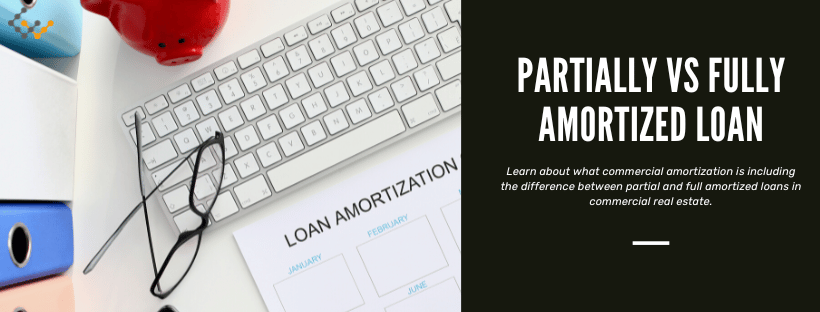Partially Amortized Loan vs Fully Amortized Commercial Loans

A partially amortizing loan is not an uncommon tool for commercial real estate investors because of the benefits it offers. All loans amortize in some way, no matter if they are commercial loans or not. There are two main options: fully amortizing and partially amortizing. Understanding the difference helps ensure investors make the best decisions about their specific needs.
What Is Amortization on a Commercial Loan?
Amortization is a term used to describe how a borrower will pay back the amount borrowed on loan over time. In all loans, a borrower agrees to make specific payments, or installments, on the loan until they pay off the amount borrowed.
An example of a fully amortized loan would be a fixed-interest rate loan for 10 years. This loan would have 120 installments paid (one per month) over the lifetime of the loan. In this situation, each one of the payments made will be equal.
That means some of the payment will go to pay down the principal of the loan, which is the actual amount borrowed. The other portion of the payment will be used to pay toward the interest.
Generally, the initial payments in a fully amortized loan will have more of the payment going towards the interest, while the principal receives a smaller portion of each installment payment. Over time, that changes so that more of the principal is paid down on loan.
This is the most common type of loan used today, but partially amortizing loans are also readily used and should be fully understood.
Answer a few questions and get custom mortgage quotes. We'll match you with offers from our network of 650+ lenders.
Partially Amortized Loan vs. Fully Amortized Loan
In a fully amortized loan, every payment is made according to the amortization schedule, which outlines how much of the payment is applied to interest and principal over the loan’s lifetime. In this situation, the borrower fully pays off the loan at the end of the loan’s term. When that loan has a fixed interest rate, each of their payments throughout this time is equal.
By comparison, a partially amortized loan uses a different type of amortization payment schedule. The entire payment, though, is not amortized in this type of loan. In this situation, the loan has a set period where the amortizing payment schedule applies. There is no specific rule to the length of this, though it tends to be between seven and nine years.
Use our free commercial real estate loan calculator to calculate your commercial mortgage and amortization schedule.
In a partially amortizing loan, once that term ends, the borrower continues to make payments each month on the loan. This method has a schedule in which the payments are set up utilizing what is considered a much longer period of time rather than the actual term of the loan. At the end of the amortization period, the remaining sum is due, sometimes referred to as a lump payment or a balloon payment.
The best way to see the difference in these loans is to compare the terms of each for the same property. Look at the monthly payment at the start of the loan and at the end of both methods.
How do Partially Amortized Loan Work on Commercial Loans?
Commercial loan amortization may include partially amortized or fully amortized loans. In the case of a partially amortized loan, which can be more common, the loan will have a specific term and an amortization period – two separate components. The amortization period tends to be longer, for example, 30 years.
The term may be shorter, for example, seven years. In this particular situation, the commercial real estate investor will make payment on the loan as if the loan was actually due in 30 years. However, the full balance of the loan is actually due within seven years.
How does that work, then? Most of the time, the commercial real estate investor will refinance the loan at the end of the term, in this case, seven years. That allows the investor to avoid making a large balloon payment at that period of time.
The most important consideration when comparing the term. In a fully amortized loan, both the amortization period and the term will be the same. In a partially amortizing loan, they will not. The amortization period is generally significantly longer than that of the term.
Advantages and Disadvantages of Partially Amortized Loans
Ultimately investors need to determine what works for their specific situation. In many cases, there are both pros and cons to using these loans that should be weighed prior to investing.
Pros of Partially Amortized Loans
There are some key benefits to partially amortizing loans.
- The loan will likely have a lower monthly payment. Because the loan payment is based on a much longer period of amortization, that spreads out the costs over a longer period of time. Lower upfront payments can help investors to keep costs down while buying the property.
- If the loan is paid off within that initial term period, it saves the investor a significant amount of money. If the investor refinances or sells the property prior to the end of that term, the investor is able to reduce how much money they put into the loan initially, and that, too, helps them to save money.
For investors who are confident they can handle the large balloon payment at the end of the term of the partially amortized loan, it can be the best way to reduce costs in purchasing real estate. Those planning on not maintaining the property long term, or those who expect interest rates to fall in the coming years prior to the term ending, may benefit from the partially amortizing loan in the meantime.
Cons of Partially Amortized Loans
There are some key drawbacks to consider about partially amortizing loans:
- The biggest negative is having to make a big payment at the end of the term. This may be financially difficult for some borrowers to do, which makes it harder for them to actually maintain the property.
- This type of loan is beneficial when the property is an investment property with the goal of turning a profit in some way. This way, the value of the profit is able to cover the cost of the balloon payment when it comes due.
- Without the ability to make a payment – or without a refinance option – the borrower will lose the property because they will default on the loan.
Understanding these risks helps investors ensure they are making a decision that works for their financial needs. Amortizing loans like this carries significant risk because the borrower is only paying a small amount of the principal borrowed at the front of the loan, leaving a much larger payment to be managed later. When the loan cannot be paid, all of the unpaid interest is added, making the final payment quite expensive.
Wrapping Things Up
Both full and partial amortized loans are used in commercial real estate. For many investors, carefully considering the options in commercial loan amortization is critical. In every situation, investors should consider how they plan to maintain the property (in a flix and flip, this could reduce costs substantially) as well as their ability to refinance at the end of the term. Understanding the consequences and benefits of these loans is critical in ensuring the right decision is made.

